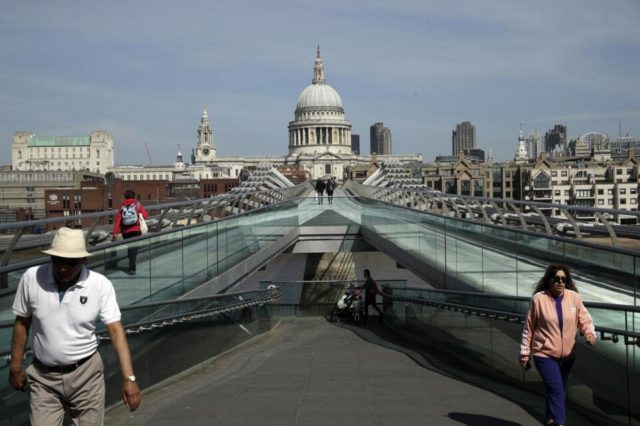A summary of steps taken or considered by the most affected nations.
Various countries around the world are
wondering when and how to ease coronavirus lockdowns, though the
World Health Organization (WHO) is warning that should be done
slowly and only when there is capacity to isolate cases and
trace contacts.
Following is a summary of steps taken or considered by the
most affected nations.
EUROPE
ITALY
, with the most Covid-19-linked deaths in Europe, is
keeping the lockdown largely in place although it lifted
restrictions on two categories of shops – stationers and
children’s clothes – on April 14.
In SPAIN
, construction and manufacturing sectors returned to
work on April 13, but the government has said the nationwide
confinement in force until April 26 would likely last until May.
FRANCE
and BRITAIN
, the two other European countries with
more than 10 000 deaths, both plan to extend current measures.
President Emmanuel Macron said schools and shops would gradually
re-open from May 11, but restaurants, hotels, cafes and cinemas
would remain shut for longer. British Health Minister Matt
Hancock said on April 16 it was too early to lift the lockdown.
GERMANY
, Europe’s largest economy, will allow stores of up
to 800 square metres (8,611 square feet), car dealers and bike
shops, to reopen from April 20, while schools will reopen on May
4.
Rebekka Hjorth holds an outdoor music lesson at the Korshoejskolen in Randers, Denmark. Denmark is beginning to relax its strict coronavirus lockdown measures by allowing some classes nationwide to return to school. Picture: Bo Amstrup/Ritzau Scanpix via AP
AUSTRIA
let non-essential shops of up to 400 square metres
(4,306 square feet), DIY shops and garden centres reopen on
April 14. Shopping malls, hairdressers and larger stores should
reopen from May 1, unless infections accelerate. Restaurants and
hotels could reopen in stages from mid-May.
DENMARK
, one of the first European countries to shut down,
reopened care centres and schools for children in first to fifth
grade on April 15. All other curbs apply at least until May 10.
POLAND
, scheduled to have a presidential election on May 10,
will gradually lift lockdown measures from April 19. The easing
will include shops but borders will remain closed until May 3.
A man peers through a window decorated with a Serbian flag during a 60-hour curfew in Belgrade. Serbia has introduced some of the harshest measures in Europe as part of efforts to curb the spread of the new coronavirus. Picture: Darko Vojinovic/AP
UNITED STATES, CANADA & LATIN AMERICA
The UNITED STATES
, which has the world’s highest infections
and deaths, is inching toward a gradual resumption of business.
President Donald Trump has cited May 1 as a target, but a
50-state patchwork of policies is likely, with many state
governors forming regional alliances to coordinate actions.
New York Governor Andrew Cuomo, whose state is the hardest
hit, said on April 15 he would begin with reopening the most
essential businesses and those with the lowest infection risk.
Some governors have warned there was no return to a
pre-pandemic “normal” until a vaccine becomes available.
Two people walk past an area meant for hundreds to wait for screening at Seattle-Tacoma International Airport in Washington. Picture: Elaine Thompson/AP
CANADA
will keep non-essential businesses shut for several
more weeks, Prime Minister Justin Trudeau said on April 14, and
the nation’s most populous province Ontario extended for another
28 days its shutdown that was due to expire on April
23.
Lockdowns are set to continue in BRAZIL
’s largest cities and
most states, with Sao Paulo extending its social distancing
measures until April 22 and Rio de Janeiro until April 30,
despite the health ministry’s suggestion that states with less
than 50% of occupancy in health systems could loosen rules.
ARGENTINA
‘s lockdown has been extended until April 26, but
the government is considering widening the list of essential
services to allow some businesses back.
MEXICO
, bracing for the spread of the coronavirus to
accelerate, is widely expected to extend the shutdown of schools
and non-essential businesses beyond April 30.
MIDDLE EAST AND AFRICA
IRAN
, the region’s worst-hit country, lifted a ban on travel
within provinces on Sunday, while restrictions on trips between
provinces end on April 20.
Businesses seen as lower risk reopened from Saturday outside
Tehran and will reopen from April 18 in the capital.
SAUDI ARABIA
has halted year-round pilgrimages to Mecca and
extended a nationwide lockdown indefinitely this week.
People wait in line to order fish to make fesikh, a traditional dish, which is eaten during the Sham el-Nessim holiday, in Cairo, Egypt. Picture: Nariman El-Mofty/AP
EGYPT
, the Arab world’s most populous nation, extended a
curfew until April 23, closed places of worship, schools and
tourist sites and banned public religious gatherings in the holy
month of Ramadan, starting late April.
ISRAEL
keeps “stay-at-home” orders for all except those who
work in vital industries, and said any exit strategy will be
“slow and responsible”.
SOUTH AFRICA
has extended a complete lockdown until the end
of April and said key sectors could be reopened gradually under
“strictly controlled conditions.”
NIGERIA
extended the lockdown of the states of Lagos, Abuja
and Ogun until April 27, exempting only critical workers,
including those selling food, water and medicine. Most large
African nations so far have no plans to ease restrictins.
ASIA-PACIFIC
CHINA
earlier this month lifted the lockdown of Wuhan, where
the outbreak began. On April 15, the city’s vice mayor said it
aimed to fully restore rail, flight and freight operations by
the end of April. Prevention measures remain elsewhere,
including Beijing.
Residents wearing masks against the new coronavirus pass by government propaganda posters featuring Tiananmen Gate in Wuhan in central China’s Hubei province. Picture: Ng Han Guan/AP
INDIA
is under lockdown until May 3, but the government will
allow some industries, such as farming and construction in rural
areas, to open after April 20.
PAKISTAN
, which extended its shutdown on April 14 by two
weeks, said some industries would reopen in phases, starting
with construction and export industries, such as garments.
In JAPAN
, a month-long state of emergency is in force in
cities since April 7, but the government has refrained from
nationwide business closures for fear of damaging the
economy.
SOUTH KOREA
, lauded for controlling its outbreak, has urged
to follow social distancing until at least April 19.
TAIWAN
, another example of a successful early response, has
avoided full lockdown but continues to promote social
distancing.
SINGAPORE
, which saw cases spike recently after early
success in containment, aims for schools and most workplaces to
reopen on May 4.
NEW ZEALAND
has no immediate easing plans with schools,
restaurants, cafes and gyms shut and its borders
closed.
Similar social distancing rules that have closed businesses
and confined people to their homes remain in place in AUSTRALIA
with no definite end date announced.
Reuters








